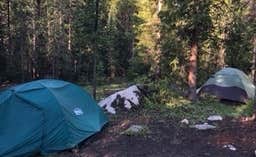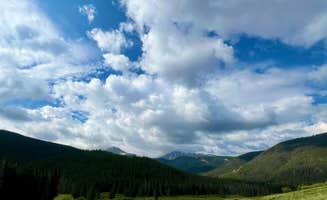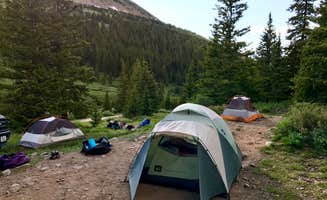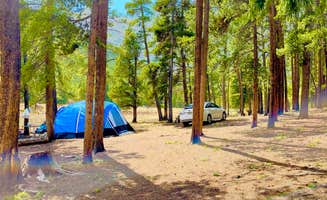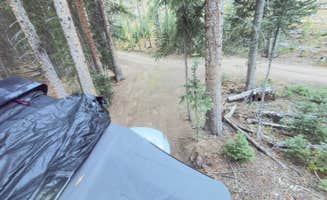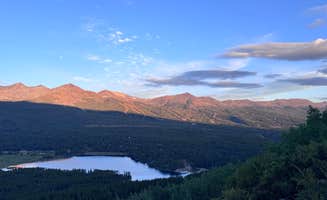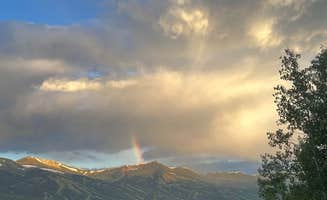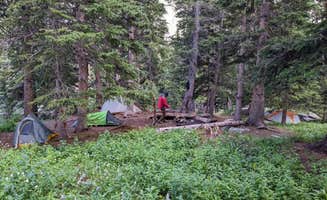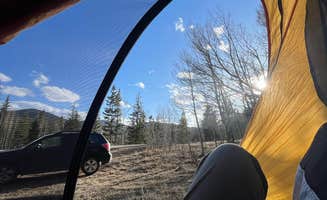Dispersed camping areas near Montezuma, Colorado sit at elevations between 9,000-11,000 feet, creating cool nights even in summer months. The surrounding Arapaho National Forest contains remnants of mining history dating to the 1860s silver boom. Weather patterns change rapidly, with afternoon thunderstorms common from June through August and early snowfall possible starting in September.
What to do
Hiking to mountain lakes: From Fall River Reservoir Dispersed Camping Trail, access nearby alpine lakes. "The hiking around it is beautiful. Would definitely camp there again," notes a recent visitor. The reservoir itself offers a scenic loop trail suitable for day hikers of moderate ability.
Off-road exploring: Forest roads provide access to abandoned mines and historic sites. At Chinns Lake Dispersed Camping, campers report "we could easily walk down to a peaceful little valley and open space" with signs of mining activity visible near several campsites.
Wildlife viewing: Mountain goat sightings are common at higher elevations. One camper at Grays Peak Trailhead mentioned "Creek, mountains, mountain goats" as highlights of their stay. Moose frequent the Peru Creek area, with visitors reporting "LOTS of moose droppings in the area" though actual sightings require patience.
What campers like
Elevation advantages: The higher altitude camping spots provide natural air conditioning during summer. At Boreas Pass Road Designated Dispersed Camping, a visitor noted "being at a higher elevation, one person in our group did experience some mild altitude discomfort, even though we're from the Denver area—something to keep in mind if you're sensitive to elevation changes."
Morning solitude: Weekday arrivals dramatically improve your chances for privacy. "We arrived on a Wednesday lunchtime and it was busy. Most sites taken," reported one camper at Kirby Gulch, suggesting mid-week morning arrivals provide better site selection options.
Established sites: Most free camping near Montezuma features established primitive campsites with existing fire rings. At Rock Creek Designated Dispersed Camping, "sites are well marked and generally spaced pretty far apart although some sites are clustered together," which helps prevent further environmental impact.
What you should know
Vehicle requirements vary: Road conditions change seasonally and require different vehicles. "Road might be a little difficult if wet as parts of it are pretty steep," notes a Rock Creek visitor, while at Bruno Gulch Dispersed, "Sites 1-8 are massive and can accommodate anything. There is also a horse corral."
Weather preparedness: Alpine conditions mean rapid temperature drops. One camper at Kirby Gulch advised, "It did get pretty cool at night, and our kids definitely let us know about it. Luckily we have extra blankets to insulate their bags."
Early arrival necessity: Summer weekends fill quickly by mid-morning. "Arrived Saturday @ ~12pm, finding a site was slim pickins but, dayum we got lucky!" reported a Peru Creek visitor, highlighting the competitive nature of summer weekend camping.
Water availability: Streams and lakes provide water but require treatment. "The creek water looks white from mining runoff so there isn't anything living in there from what I can tell. It looks really cool but its probably not safe," warned one Peru Creek camper regarding water quality in certain areas.
Tips for camping with families
Accessible options: Not all dispersed sites require technical driving. "The first 30 or few spots are a little close, accessible for most vehicles but fills up quickly," noted one visitor to Kirby Gulch, making these front sites better for families with standard vehicles.
Creek access: Children enjoy shallow stream exploration opportunities. "Our site was higher up the road—still accessible, but just rough enough to turn a few others back. That bit of elevation gave us a quiet pocket, a breeze, and just enough distance from the traffic circling below," shared a Rock Creek camper whose family found the perfect balance of accessibility and privacy.
Wildlife education opportunities: Multiple campgrounds report moose activity. "We had moose visitors right by camp each day which was cool but be sure to respect the wildlife and give them space," advised a camper at Fall River Reservoir, creating natural learning experiences for children.
Temperature fluctuations: Pack extra warm layers regardless of season. "It was in the mid 30s at night," reported one camper about summer temperatures, suggesting families need sleeping bags rated for at least 30°F even in July and August.
Tips from RVers
Size-appropriate sites: Smaller RVs and vans have more options than large rigs. "Pullouts are pretty tight so best for vans type camping. Maybe larger sites further up the mountain," noted a visitor at Boreas Pass, indicating size limitations at many dispersed sites.
Site selection strategy: Arriving early lets RVers find level sites with adequate space. "We have a 4wd Sprinter with slightly larger tires, and pulling an off-road trailer. We made it with ease," mentioned a Peru Creek camper, but cautioned "again, we got lucky w/ site 14 as it's tough to see from the road."
Road clearance assessments: Technical roads limit larger vehicles. "There are potholes to contend with and some mid-sized rocks that did have us rockin' and rollin' from side to side. Slow roll it and you'll be fine," advised an experienced RVer about the Peru Creek access road, suggesting careful navigation rather than speed is the key to success.
Elevation considerations: Higher campsites mean cooler temperatures and potential altitude issues. "We were at site 17. Best view in my opinion. Road is fine for high clearance. But all of us with 4wD ask that you move over for us," noted a van camper at Boreas Pass Road, highlighting both the reward and responsibility of RV camping in the high country.


